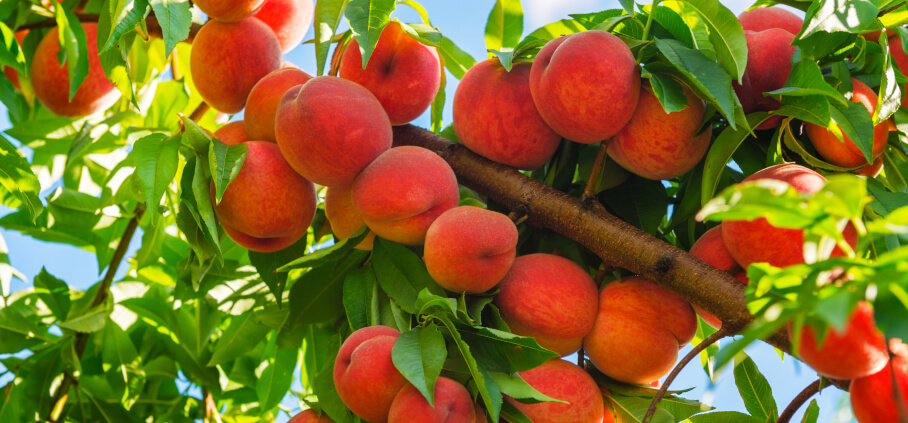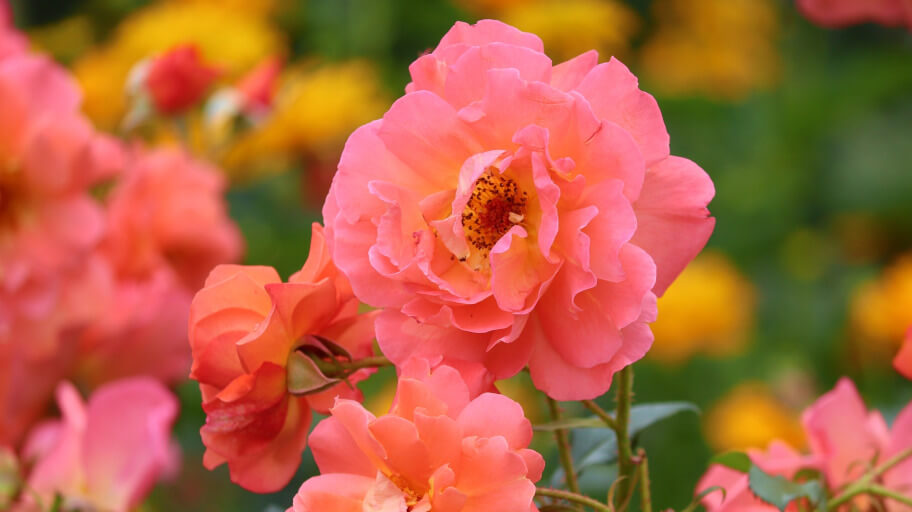
Peach trees can make for a lovely addition to every garden in Australia. They produce delicious, sweet fruits and are among the least demanding fruit trees. As peach trees ripen very early in the season, the harvest stays mostly unaffected by diseases and pests. However, to keep your tree healthy and improve the yield, an annual pruning routine is required. But don’t worry, this gardening technique is fairly simple. To help you maintain the healthy appearance of your fruit tree, we’ve put together all the information required on how to prune a peach tree.
In this article:
When to prune peach trees
To determine when is the best time to prune a peach tree, you will need to consider your goals. Do you want to reduce the size of a peach tree? Or do you want to encourage faster growth? Choosing the right time of the year can help you achieve the desired results. But why do the seasons matter? This is mainly connected to the tree’s seasonal cycle of energy. For example, winter pruning helps spur vigorous growth in young trees, but if your tree is already overgrown and tall and you want to reduce its size, it is best to do the pruning in the summer
Winter
Winter is generally considered the best time to do the annual tree pruning. At this time of year, trees store energy in the roots and don’t grow. This means that in the forthcoming spring, the energy will be unleashed, focusing only on the healthy branches and won’t be wasted on the poorly conditioned branches. The benefits of winter pruning are that it encourages faster growth and ensures the tree’s cutting wounds will be healed soon in spring. Also, during winter, when the tree is stripped of its leaves, it is easier to see its structure and determine the quality of each branch.
Spring
The best time for orchardists to prune older peach trees is in spring because it won’t spur growth. When the days become warmer, fruit trees emerge from dormancy and the stored up till now energy is finally realised to the branches. This energy is used to fuel the growth of new branches and the blossoming of buds. This time of year is best for larger trees because it will help contain their growth. Moreover, when it has blossomed it is easier to identify which branches are dead and which are healthy.
Summer
With the beginning of summer, spring growth slows down as stored energy has already been used for producing blossoms, leaves and fruits. Now the tree begins to produce energy from photosynthesis to fuel the summer growth. Summer pruning is suitable for larger trees because it will reduce vigorous growth in peach trees.
However, it is not advisable for young trees because, at this time of year, the tree doesn’t have enough energy and it will slow down the growth.
Autumn
Autumn pruning is considered a no-go. When the weather gets colder, the trees begin preparing for dormancy by moving the food, produced from photosynthesis, down into the roots. If you cut the peach branches in autumn you will leave open wounds. The tree won’t have the energy to produce a protective layer of cells and heal. This will make it prone to diseases.
How to prune peach trees
As already mentioned, to keep your peach tree looking pretty and well-kept, proper maintenance is required. Peach trees are pruned in a V-shape with outer branches growing out of the trunk into 45-degree angles. This is best achieved by removing branches from the central space and making sure the scaffold branches are evenly spaced. Leaving enough free space in the tree crown is essential to ensure enough sun and air are getting through. Don’t be scared to prune extensively. To encourage fresh growing branches in mature trees, around 40% of last year’s growth will need to be cut off.
This might sound hard to achieve, but in fact, peachtree pruning is a fairly easy gardening technique, as long as you know what you are doing. To help you achieve a healthy tree shape, we have prepared a simple step-by-step guide. Here is what you need to know about pruning a peach tree:
What you will need:
- Bypass garden pruners
- Long-handled pruners
- Pruning saw (optional)
- Ladder (optional)
- Thick gloves
- Long-sleeved shirt
Step-by-step guide
- Clean up damaged, dead or diseased branches
Known as the “Three D’s” of pruning, you will need to remove any branches that are visibly in poor condition. This is especially important for fruit-bearing trees like the peach tree. Use long-handled pruners or a pruning saw to remove the branches.
- Select the main branches
Choose the branches you want to keep, they should be growing upward, and the ones you want to remove. The goal is to create a V-shaped tree profile. Get rid of narrowed branches that won’t withstand the weight of fruits. Make sure to leave enough space from the ground (45cm at least). Prune any downward or horizontal growing branches and cut central branches to free space inside the tree crown.
- Prune off red shoots
Cut back newly grown red shoots. You will need to maintain a length of approximately 45cm. The goal here is to keep the shoots close to the main branches so they are wiry and can support the fruit. Moreover, remove old grey shoots since they no longer can produce fruit.
- Get rid of suckers
Look out for sprouts, the so-called suckers, at the base of the tree trunk or water-sprouts growing from the main branches. Cut those off without living stubs. If they are small enough, you can pull them off with your hand. If they are pulled off instead of cut, it is less likely that they will regrow.
- Trim the edges
You will need to prune the tree into a harvestable height. Make that by trimming the ends of branches that have grown too tall. This helps the branches to grow strong and thick.
Pruning dwarf peach trees
Dwarf peach trees look adorable and make possible the fruit growing in smaller gardens where the space is limited. That is why many choose this miniature version. Because of their smaller size, those trees are easier to maintain and harvest. But don’t let that delude you, they still require the same love and care as the full-sized peach trees. Annual pruning improves the structure and health of dwarf peach trees and ensures they stay compact and manageable.
Pruning dwarf peach trees doesn’t differ much from pruning regular peach trees. They are still trimmed into a V-shape and require free space in the tree crown for sun and air. Remove branches that are damaged, dead or crossing and rubbing on each other. The best time of year to do the pruning is in the late winter or early spring before the tree has blossomed and grown leafy. Prune heavily in the first one to three years. This might deprive you of a huge harvest at first, but in the long term, it will make the tree stronger and healthier.
Watching on tree pruning with unease?
Hire a professional gardening team!
Takeaways
- Peach trees are easy to maintain but require annual pruning to grow, be healthy and produce good quality peaches.
- The best time of year for pruning a peach tree is during late winter or early spring, but it also depends on whether you want to spur growth or not.
- Peachtree pruning partly consists of trimming the edges and removing any dead or damaged branches.
- Dwarf peach trees require similar care to regular-sized trees.








